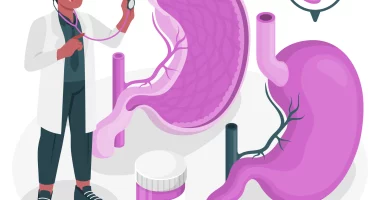Chronic kidney disease (CKD) is a condition where the kidneys slowly lose their capability to work properly over many years. In the early stages, CKD often doesn’t cause any noticeable symptoms, so people might not even know they have it. However, as the disease progresses, it can lead to serious health problems like high blood pressure and swelling in the body because the kidneys can’t remove excess fluid effectively. If CKD continues without proper treatment, it can eventually cause the kidneys to fail.
In the U.S., about 35.5 million individuals, or roughly 14 percent of the population, are affected by CKD. Unfortunately, CKD often goes unnoticed until it has advanced to a more severe stage, making early detection challenging.
Certain groups, like Hispanics, African Americans, Asian Americans, and Native Americans, are at a higher risk of getting CKD compared to white individuals. This increased risk might be related to differences in access to and quality of primary healthcare for these populations.
As CKD worsens, harmful waste products can build up quickly in the body, posing significant health risks. The main goal of treatment is to slow down or prevent further damage to the kidneys by addressing the underlying causes, like managing high blood pressure or controlling diabetes. Early intervention is crucial to help maintain kidney function and prevent complications.
Symptoms
Individuals who have a high chance of developing CKD should have regular kidney function checks. Early identification is essential because it can assist in preventing serious kidney damage and managing the condition before it worsens.
Recognizing the symptoms of CKD is important for early intervention. Common symptoms include high blood pressure (hypertension), anemia, and swelling in the hands, feet, and ankles (edema). Fatigue or a general feeling of tiredness is also common. As the disease progresses, there may be a decrease in urine production, and in some cases, the urine may appear bloody or dark.
In more severe cases, CKD can lead to a decrease in mental alertness and persistent itchy skin. People with CKD might also experience a loss of appetite and more frequent urination, particularly at night. Being aware of these symptoms can help individuals seek medical attention sooner, potentially slowing the progression of the disease.
Causes
The kidneys play a crucial role in filtering excess fluid and waste from the blood, which is then excreted from the body. However, several problems can disrupt this filtration system. These issues may arise if the blood flow to the kidneys is insufficient if the kidneys themselves are diseased or damaged, or if there is an obstruction preventing urine from flowing out of the body. CKD often develops as a result of hypertension or diabetes. In unmanaged diabetes, high levels of sugar in the blood can destroy the kidneys, while high blood pressure can harm the glomeruli, the kidney parts responsible for filtering waste.
Other causes of CKD include obstructed urine flow, which can occur due to kidney stones, or tumors, and an enlarged prostate leading to increased pressure towards the kidneys. Various kidney diseases, such as polycystic kidney disease, glomerulonephritis, and pyelonephritis, can also contribute to CKD. Additional factors include kidney artery stenosis, heavy metal poisoning (like lead), developmental issues in the fetus, autoimmune conditions such as systemic lupus erythematosus, and infections like yellow fever and malaria. Overuse of certain medications, illegal substance use (e.g., cocaine or heroin), and physical injury can further increase the risk of CKD.
Diagnosis
When diagnosing CKD, a healthcare provider will first look for signs of the disease and ask about the person’s symptoms. To confirm the diagnosis and assess the severity, the healthcare provider may order several examinations:
- Urine Test: It is commonly used to check for the presence of a protein called albumin. Normally, albumin should not be found in urine, but when the kidneys are damaged, they can leak albumin into the urine. Detecting albumin can be an early sign of kidney damage.
- Kidney Scans: Imaging tests like ultrasound are often used to examine the shape and size of the kidneys. These scans help healthcare providers identify any abnormalities or changes in the kidneys that may indicate CKD. In some cases, healthcare providers might use more detailed imaging techniques like CT scans or MRIs. However, CT scans are less commonly used because they involve contrast dyes that can be harmful to the kidneys, especially in people with existing kidney problems.
- Kidney Biopsy: If more detailed information is needed, a healthcare provider may perform a kidney biopsy. This involves taking a small tissue of kidney tissue, which is then examined under a microscope to look for signs of damage or disease.
- Chest X-ray: Sometimes, healthcare providers will order a chest X-ray to identify pulmonary edema, which is the buildup of fluid in the lungs.
- Estimated Glomerular Filtration Rate: The eGFR test measures how well the kidneys are filtering waste from the blood.
These tests help healthcare providers diagnose CKD, understand its severity, and create an appropriate treatment plan to manage the condition.
Treatment
The damage caused by CKD is typically permanent, but certain treatments can help manage symptoms, decrease complications, and reduce the disease’s progression.
High blood pressure
One of the key issues that CKD patients face is high blood pressure, which can either be a cause or a result of CKD. Managing blood pressure is crucial for protecting the kidneys and slowing the advancement of the disease. Treatment often includes medications to lower blood pressure, along with lifestyle modifications like eating a healthy diet and doing regular exercise.
Anemia
Anemia is another common complication of CKD. Hemoglobin, the substance in cells of red blood responsible for carrying oxygen throughout the body, can be low in CKD patients, leading to anemia. Treatment often involves injections of erythropoiesis-stimulating agents, which help stimulate red blood cell production by mimicking a protein normally produced by the kidneys.
Phosphate balance
Phosphate balance is also important for CKD patients, as their kidneys may struggle to rule out phosphate properly. To manage this, patients might be required to take phosphate binders to regulate how much phosphorus is absorbed from food. They may also need to reduce their intake of foods high in phosphate, like dairy products, eggs, fish, and red meat.
Skin itching
In advanced stages of CKD or for those undergoing dialysis, skin itching can be a troublesome symptom. Itching can affect sleep and quality of life. Dermatologists can provide treatments like topical emollients, antihistamines, or moisturizers to help manage this symptom.
Vitamin D deficiency
Vitamin D deficiency is another concern for individuals with CKD, as the kidneys play a key role in activating vitamin D from the food or sun. Without enough vitamin D, bones can become weak, leading to conditions like fractures or osteoporosis. Supplementation is often necessary, with healthcare providers determining the appropriate dosage based on the person’s needs.
Fluid retention
Fluid retention is a serious issue in CKD, as the kidneys’ inability to function properly can lead to an accumulation of fluids in the body. To manage this, patients need to monitor their fluid intake and limit salt consumption, as excess sodium can worsen fluid retention, leading to high blood pressure and further kidney damage, as well as serious heart issues. Managing fluid and salt intake is crucial to avoid these complications.
Risk Factors
The risk factors for CKD often overlap with its causes. Beyond high blood pressure and diabetes, several other factors increase the likelihood of developing CKD. A history of kidney disease in a family significantly raises the risk, as does advancing age, with CKD being more common in people aged 60. Obesity is another key risk factor, as it can contribute to the development of conditions like diabetes and hypertension that harm the kidneys. Additionally, individuals with heart disease or those who have previously sustained kidney damage are at higher risk of developing CKD.
Race and ethnicity also play a significant role in the risk of CKD. As per the National Institute of Diabetes and Digestive and Kidney Diseases, Hispanic, African American, and Native American people are at a higher risk of developing CKD compared to white individuals. This disparity highlights the need for targeted awareness and preventive measures within these communities.
Complications
As CKD increases to kidney failure, it can lead to several serious complications. These may include anemia, where there is a deficiency of red blood cells; fluid retention, which can cause swelling and increased blood pressure; and gout, a type of arthritis caused by the accumulation of uric acid crystals in the joints. Heart disease is another potential complication, along with hyperkalemia, a condition characterized by elevated potassium levels in the blood that can lead to heart damage or disease. Metabolic acidosis, the accumulation of acid in the body, and secondary hyperparathyroidism, where imbalances in calcium, vitamin D, and phosphorus occur, are also common complications associated with advanced CKD.
Prevention
To prevent and manage CKD, it’s important to control conditions like diabetes that increase risk. Following a healthcare provider’s advice, maintaining a healthy diet, and engaging in regular physical activity are key. A diet rich in whole grains, fruits, vegetables, and lean meats can help lower blood pressure, while regular exercise aids in controlling blood pressure and managing chronic conditions like heart disease and diabetes. Additionally, avoiding alcohol and drug consumption, in addition to long-term contact with heavy metals and toxic chemicals, is crucial for kidney health. It’s also important to address systemic disparities in healthcare that impact certain groups, such as African American, Native American, Hispanic, and Asian American populations, who may face faster progression of CKD and delayed treatment. Proactively seeking medical advice and testing can help mitigate these risks and improve outcomes.
Summary
Chronic kidney disease is a progressive condition that can lead to serious complications, including anemia, fluid retention, gout, heart disease, and metabolic imbalances. Risk factors for CKD include diabetes, hypertension, heart disease, obesity, and a family history of kidney issues. CKD disproportionately affects Hispanic, African American, and Native American communities. Managing CKD involves controlling symptoms, slowing disease progression, and addressing complications to enhance quality of life. Early detection and targeted treatments are crucial to prevent kidney failure and associated health risks.









